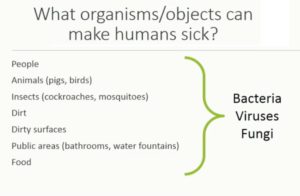Difference Between Fungi And Bacteria With Comparison Table In Detail
We explain the difference between fungi and becteria in detail with comparison table. Fungi and bacteria are two types of organisms whose characteristics can be easily confused but are definitely not the same. In fact, both make up two of the six biological kingdoms currently considered; Archae, Bacteria, Protista, Fungi, Plantae and Animalia, although fungi can belong to two or more kingdoms ( Protista, Protozoa and Chromista ), depending on the scheme of kingdoms that you prefer to consider.
Differences Between Fungi And Bacteria
 In biology, there are two basic organisms such as fungi and bacteria. These organisms are a fundamental part of our lives, because many of them are necessary for us and for other living beings, although not all of them are good. In fact, in our body, it is estimated that there are more than 100 billion bacteria and many of them intervene in processes such as the assimilation of food, synthesis of vitamins, among others.
In biology, there are two basic organisms such as fungi and bacteria. These organisms are a fundamental part of our lives, because many of them are necessary for us and for other living beings, although not all of them are good. In fact, in our body, it is estimated that there are more than 100 billion bacteria and many of them intervene in processes such as the assimilation of food, synthesis of vitamins, among others.
 Likewise, fungi are used in some industrial processes for the production of beverages and food. The clearest example of the use of a fungus in industry and at home is yeast, which is used to make bread.
Likewise, fungi are used in some industrial processes for the production of beverages and food. The clearest example of the use of a fungus in industry and at home is yeast, which is used to make bread.
However, to understand their differences it is first necessary to know their concepts. This will help us understand how they act and what they do. To do this, we must know that all living beings can be classified from the cellular point of view, so we will also cover that topic.
Mushrooms
 We can point out that fungi are eukaryotic organisms among which we can find yeasts and molds, as well as mushroom producers. Previously, the fungi belonged to the kingdom plantae (plants and algae) but it was discovered that they had very particular characteristics, so they were classified in the kingdom fungi.
We can point out that fungi are eukaryotic organisms among which we can find yeasts and molds, as well as mushroom producers. Previously, the fungi belonged to the kingdom plantae (plants and algae) but it was discovered that they had very particular characteristics, so they were classified in the kingdom fungi.
 Mushrooms are used in different areas, some can be consumed due to the vitamins and proteins they provide. In addition, many of them, such as yeasts, are used in industrial processes such as beer production and for the production of bread, because they intervene in the fermentation process. However, not all of them are beneficial, so some affect different materials, such as mold and some others are poisonous and fatal to be consumed.
Mushrooms are used in different areas, some can be consumed due to the vitamins and proteins they provide. In addition, many of them, such as yeasts, are used in industrial processes such as beer production and for the production of bread, because they intervene in the fermentation process. However, not all of them are beneficial, so some affect different materials, such as mold and some others are poisonous and fatal to be consumed.
Bacteria
 It is known that batteries are prokaryotic microorganisms, that is, unicellular, which in organic matter and living beings can produce fermentation and also cause diseases. They are considered the most abundant organisms on the planet. They belong to the bacterium kingdom and can be found in both terrestrial and aquatic habitats. Bacteria can grow in the most extreme environments, such as the deep sea and in extremely hot and acidic climates, they can even grow on radioactive waste.
It is known that batteries are prokaryotic microorganisms, that is, unicellular, which in organic matter and living beings can produce fermentation and also cause diseases. They are considered the most abundant organisms on the planet. They belong to the bacterium kingdom and can be found in both terrestrial and aquatic habitats. Bacteria can grow in the most extreme environments, such as the deep sea and in extremely hot and acidic climates, they can even grow on radioactive waste.
 Some bacteria are responsible for the decomposition and infections that act on the human body, with some deadly bacterial diseases, such as tuberculosis, responsible for almost two million deaths of people a year. That is why so-called antibiotics are used worldwide to treat these bacterial infections.
Some bacteria are responsible for the decomposition and infections that act on the human body, with some deadly bacterial diseases, such as tuberculosis, responsible for almost two million deaths of people a year. That is why so-called antibiotics are used worldwide to treat these bacterial infections.
 For all the aforementioned, in addition to the tacit differences in the definitions, the following comparative table is presented whose purpose is to highlight the obvious differences between fungi and bacteria.
For all the aforementioned, in addition to the tacit differences in the definitions, the following comparative table is presented whose purpose is to highlight the obvious differences between fungi and bacteria.
Differences Between Fungi And Bacteria Table
| Mushrooms | Bacteria | |
|---|---|---|
| Description | Also called fungi, fungi make up a kingdom of their own. Fungi are heterotrophic organisms (which cannot make their own food), with cell walls made of chitin. These reproduce by means of spores which, after finding an ideal environment, begin to germinate. In addition, fungi can live in very diverse and adverse environments. For example, they can be found from deserts to the seabed, through extremely saline environments, exposed to radiation and so on. Yeasts, molds, and mushrooms are fungi. Mycology is the specialty area of biology that deals with the study of fungi. | On the other hand, bacteria, which also make up their own kingdom, are microorganisms that are found practically everywhere. They can be found on land, in water, in very hot, very cold, acidic and even radioactive environments, as well as outer space (carried by humans for experimentation). Bacteria are the most abundant organisms on the planet, up to 40 million bacterial cells can be found in one gram of earth. These can take various forms, for example filaments, rods and helixes. Bacteriology, which is a branch of microbiology, is the science in charge of its study. |
| Domain | They are eukaryotic organisms. | They are prokaryotic microorganisms.. These types of organisms do not have a defined nucleus. |
| Size | The mushrooms do not have a specific size. Some are just microscopic unicellular organisms. Others, such as the famous honey fungus from Oregon , United States, whose rhizomorphic filaments extend over 880 hectares and which has lived for more than 2,400 years (it is the largest organism in the world) reach surprising sizes. | As for bacteria, they barely measure between .5 and 5 μm (micrometers) in length. |
| Relationship with the human being | Mushrooms are very important for humans, since they are an elemental part of different processes such as the manufacture of bread and beer. In addition, of course, there are mushrooms suitable for human consumption such as truffles. Even the enzymes of some fungi are used in the manufacture of medicines. However, there are also fungi that can be harmful to humans and other organisms. Such is the case of poisonous mushrooms, which can poison and even cause the death of those who consume them, and parasitic mushrooms that infect a person or animal can make them sick (such as the fungus that causes athlete’s foot). | In the human body there are 10 times more bacterial cells than human cells. These are mainly concentrated in the skin and digestive tract. Most bacteria are either beneficial or harmless. For example, some of these are an important part of the manufacturing processes of butter, vinegar, yogurt and cheese, in addition to some medicines and other compounds. However, there are others that can make people very sick. Among the most common or known infections caused by bacteria are leprosy, syphilis, cholera, diphtheria, etc. |
| More Information | Fungi are multicellular organisms. | Bacteria are single-celled organisms. |
| All fungi are heterotrophic, they cannot produce their own food. | They can be autotrophic and heterotrophic, so some can generate their own food and others cannot. | |
| They are all aerobic, due to which they all need oxygen to develop. | Some are aerobic and some are anaerobic, which means that some need oxygen and some don’t. | |
| Fungi reproduce sexually and asexually, through fragmentation, budding (asexual), and spores. | Batteries reproduce asexually, through binary fission or bipartition that gives rise to two daughter cells, resulting in exponential growth. |
Related Topics


